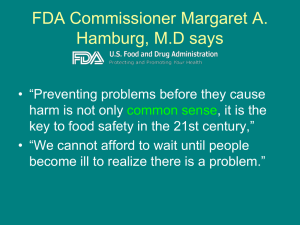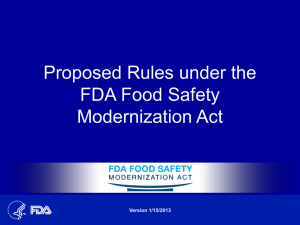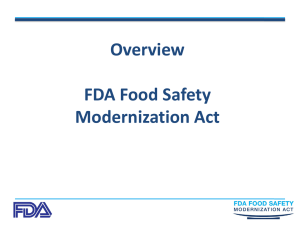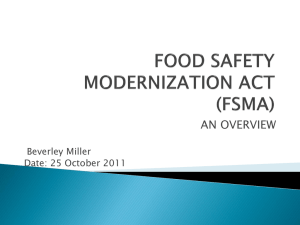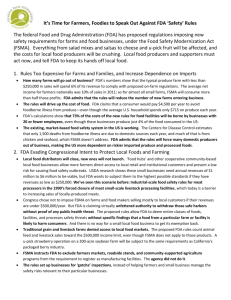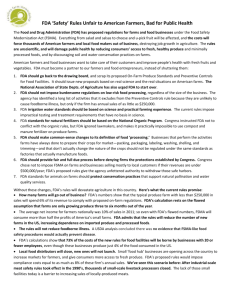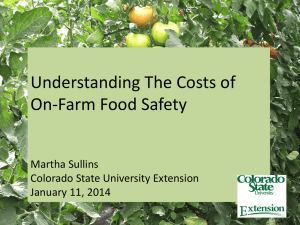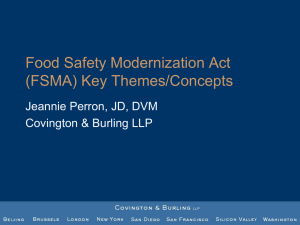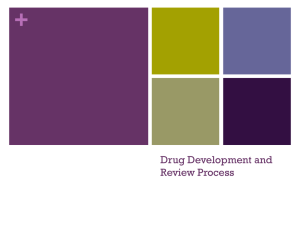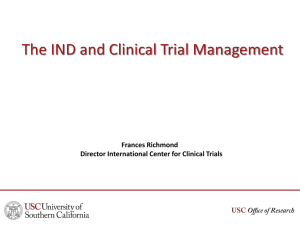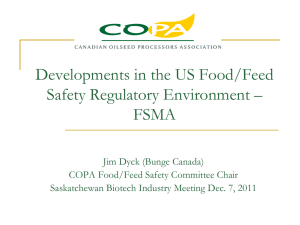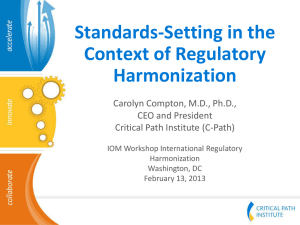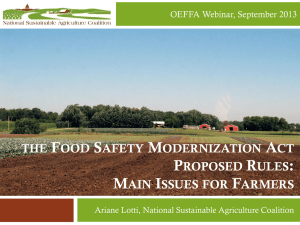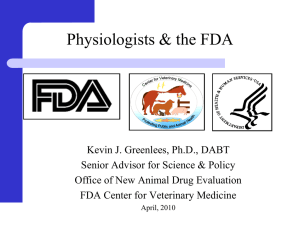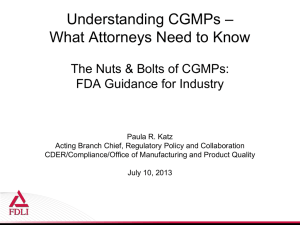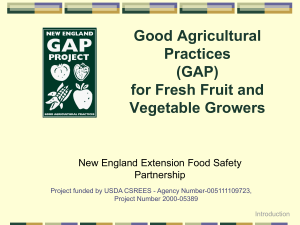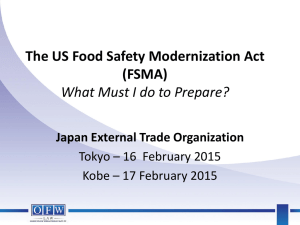FDA Food Safety Modernization Act
advertisement
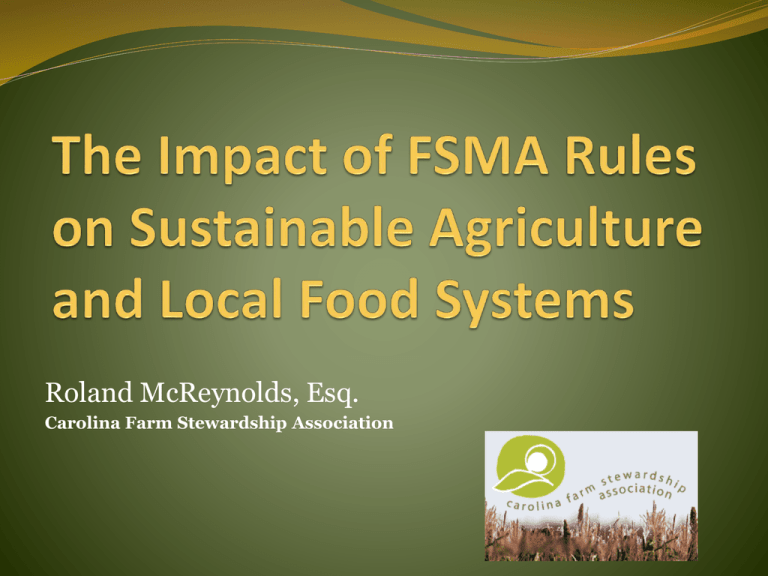
Roland McReynolds, Esq. Carolina Farm Stewardship Association About CFSA Member-based, farmer-driven non-profit with a mission to advocate, educate, and build the systems to support a sustainable food system in the Carolinas centered on local and organic agriculture Heavily engaged in FSMA legislative process Active in developing comments on FSMA proposed rules on behalf of sustainable ag Provides food safety training tailored to diversified and organic farms The Real Public Health Crisis Annual Deaths from Diet-Related Diseases Heart disease: 806,156 Diabetes: 231,402 Colon/rectal cancer: 54,433 Use of Conventional Pesticides Increasing As much as 93% of Americans have chlorpyrifo residues Implicated in diabetes, ADHD, birth defects, cancers Overuse of synthetic fertilizers, pesticides contaminating aquifers, fisheries, estuaries, etc. Processing a Higher Risk 99% of outbreaks in leafy greens between 1999 and 2007 were from bagged, ready-to-eat products Cutting leafy greens post-harvest vastly multiplies pathogen growth risk Shelf-life-extending packaging (clamshells) can promote pathogen growth Comingling product from large number of farms makes entire product batch vulnerable to safety lapse New FDA Powers FDA can order a recall of food. FDA can detain food if there is a “reason to believe” the food is not produced in accordance with safety regs FDA has the power to suspend the operations of any food facility if there is a reasonable probability of causing serious adverse health consequences or FDA can require safety certification for imported food to be certified FDA must review health data every 2 years and issue guidance documents or regulations to address the most significant foodborne contaminants FDA is required to establish a product tracing system FSMA: One Statute, Many Regulations Produce safety standards Preventive controls in food processing ‘facilities’ Preventive controls in manufacture of animal feed Prevention of intentional contamination Sanitary transportation Foreign supplier verification FSMA Rules Timeline Legislative deadline for implementing final produce safety and facility preventive controls rules would have been 2013 Proposed produce and facilities rules published in 2013; comment period closed Nov. 22 Northern District of CA judge has set June. 2015 as final deadline for all FSMA rules FDA has already stated it will republish at least parts of produce and facilities proposed rules for further public comment FSMA Rules Timeline, cont’d Staggered timelines for application of both rules, based on size of business Produce Rule: Large farms (>$500,000) subject to compliance 2 years after final rule publication; Small farms (<$500,000) get 3 year phase-in; Very Small (<$250,000) farms get 4 years Facilities Rule: Large firms get 1 year; Small get 3 years; Very Small get 4 years Proposed Produce Rule Key standards: Personnel qualifications/Worker health and hygiene training (SUBPART C & D) Water (SUBPART E) Animal-derived soil amendments (SUBPART F) Animals (wildlife and domestic) (SUBPART I) Facilities and food contact surfaces (equipment, tools, instruments and controls, transport) (SUBPART L) Plus additional, special rules for sprouts Proposed Facilities Rule Key standards: Good Manufacturing Practices: Updates existing GMP regulations in 21 CFR 110 Hazard Analysis and Risk-Based Preventive Controls: Requires every food facility to have written food safety plan hazard analysis food safety plan monitoring corrective actions validation of plan periodic reanalysis and revision of plan documentation Congressional Protections for Local Food, Conservation Scale appropriate regulations and options for small and mid-sized farms serving local and regional markets (Tester-Hagan Amendment) Ensure protection of beneficial on-farm conservation and wildlife practices Complement – not contradict – National Organic Program regulations Congressional Protections for Local Food, Conservation, cont’d Minimize extra regulations for low-risk processing that is part of value-added production Streamline and reduce unnecessary paperwork for farmers and small processors Allow farm identity preserved marketing as an option in place of government trace-back controls Funding for training through new competitive grants program How Did FDA Do? Ag water subjected to EPA recreational water quality standards, weekly testing No approved treatment for irrigation water that exceeds EPA recreational water standards; but treating water gets farm out of testing requirement No scientific basis for applying EPA recreational water standard to irrigation water Far more stringent threshold than World Health Organization irrigation water standards No analysis of what surface waters meet this standard How Did FDA Do? Compost and manure fertilizer subject to more stringent rules than National Organic Program More than doubles the length of ‘withdrawal’ period between application of manure and harvest of produce allowed under NOP—longer than the growing season in most parts of the country No scientific basis for limitations on use of compost Ignores evidence of effectiveness of biological soil amendments in controlling pathogens Increased use of synthetic fertilizers How Did FDA Do? Local food businesses at competitive disadvantage Farms treated as ‘facilities’ Small food processors sell 4% of food, will bear 73% of compliance costs FDA acknowledges wide variety of ‘processing’ activities are low risk, but regulates them as high risk anyway If large facilities are already in compliance, what does that say about whether these standards will enhance prevention of foodborne illness outbreaks? How Did FDA Do? Small farms and businesses denied due process Statutory protections can be withdrawn for almost any reason No opportunity to reinstate those protections if it turns out FDA was wrong, or any problem is corrected All a farm’s product sales count toward whether farm is protected or not, even sales of products that aren’t actually regulated by FDA How Did FDA Do? Wildlife habitat not targeted by the rules, but not promoted by them either Preamble language acknowledges that habitat and vegetation around fields does not need to be removed, and may even support food safety But statutory language doesn’t encourage those practices Private standards and some buyers likely to continue to pressure farms to remove habitat, buffers Agriculture United for the First Time Ever National Association of State Depts. of Agriculture calls for ‘do over’ on proposed rules Produce industry outcry from large and small entities alike Belated Environmental Impact Statement Roland McReynolds Executive Director Carolina Farm Stewardship Association PO Box 448 Pittsboro, NC 27312 (919) 542 2402 roland@carolinafarmstewards.org www.carolinafarmstewards.org

